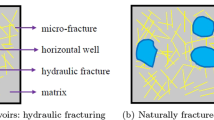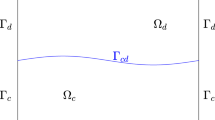Abstract
In this report, we study a partitioned time stepping algorithm for a dual-porosity-Stokes model, which consists of dual-porosity media and macrofractures/conduits in the coupled system. More specifically, the dual-porosity-Stokes model uses two pressures, the matrix pressure and the fracture pressure, to couple with the Stokes equations. There are four physically valid interface conditions to couple the two models on the interface, including a no-exchange condition, a mass balance condition, a force balance condition, and the Beavers–Joseph condition. To decouple the complex model into three simple sub-problems and solve them separately, we propose a partitioned time stepping method. It solves one, uncoupled matrix pressure equation, microfracture pressure equation and Stokes equation per time step. Under a modest time step restriction of the form \(\triangle t\le C\)(depending on physical parameters) , we prove the stability of the method. We also derive its optimal error estimates. Numerical tests verify the theoretical results.


Similar content being viewed by others
References
Beavers, G., Joseph, D.: Boundary conditions at a naturally permeable wall. J. Fluid Mech. 30, 197–207 (1967)
Connors, J.M.: Partitioned time discretization for atmosphere–ocean interaction. University of Pittsburgh, Pittsburgh (2010)
Cao, Y., Gunzburger, M., He, X., Wang, X.: Parallel, non-iterative, multi-physics, domain decomposition methods for the time-dependent Stokes–Darcy model. Math. Comput. 83(288), 1617–1644 (2014)
Cao, Y., Gunzburger, M., Hu, X., Hua, F., Wang, X., Zhao, W.: Finite element approxiations for Stokes–Darcy model with Beavers–Joseph interface boundary condition. SIAM J. Numer. Anal. 6, 4239–4256 (2010)
Cao, Y., Gunzburger, M., Hua, F., Wang, X.: Coupled Stokes–Darcy model with Beavers–Joseph interface boundary condition. Commun. Math. Sci. 8, 1–25 (2010)
Cao, Y., Gunzburger, M., He, X.M., Wang, X.: Robin–Robin domain decomposition methods for the steady Stokes–Darcy model with Beaver–Joseph interface condition. Numer. Math. 117(4), 601–629 (2011)
Connors, J.M., Howell, J.S., Layton, W.J.: Decoupled time stepping methods for fluid–fluid interaction. SIAM J. Numer. Anal. 50(3), 1297–1319 (2012)
Connors, J.M., Howell, J.S., Layton, W.J.: Partitioned time stepping for a parabolic two domain problem. SIAM J. Numer. Anal. 47(5), 3526–3549 (2009)
Chen, W., Gunzburger, M., Sun, D., Wang, X.: Efficient and long-time accurate second-order methods for the Stokes–Darcy system. SIAM J. Numer. Anal 51(5), 2563–2584 (2013)
Chen, W., Gunzburger, M., Sun, D., Wang, X.: An efficient and long-time accurate third-order algorithm for the Stokes–Darcy system. Numer. Math. 134, 857–879 (2015)
Discacciati, M., Miglio, E., Quarteroni, A.: Mathematical and numerical models for coupling surface and groundwater flows. Appl. Numer. Math. 43, 57–74 (2002)
Guo, C., Wei, M., Chen, H., He, X., Bai, B.: Improved numerical simulation for shale gas reservoirs, OTC-24913. In: Offshore Technology Conference Asia, Kuala Lumpur, Malaysia (2014). https://doi.org/10.4043/24913-MS
Hou, J.Y., Qiu, M., He, X.M., Guo, C.H., Wei, M.Z., Bai, B.J.: A dual-porosity-Stokes model and finite element method for coupling dual-porosity flow and free flow. SIAM. J. Sci. Comput. 38–5, B710–B739 (2016)
He, X.M., Li, J., Lin, Y., Ming, J.: A domain decomposition method for the steady-state Navier–Stokes–Darcy model with Beavers–Joseph interface condition. SIAM J. Sci. Comput. 37(5), S264–S290 (2015)
Jaeger, W., Mikelic, A.: On the interface boundary conditions of Beavers, Joseph and Saffman. SIAM J. Appl. Math. 60, 1111–1127 (2000)
Kubacki, M.: Uncoupling evolutionary groundwater-surface water flows using the Crank–Nicolson LeapFrog method. Numer. Methods Partial Differ. Equ. 29, 248–272 (2013)
Lions, J.-L., Magenes, E.: Probl\(\acute{e}\)mes aux limites nonhomog\(\grave{e}\)nes at applications, vol. 1. Dunod, Paris (1968)
Layton, W.J., Schieweck, F., Yotov, I.: Coupling fluid flow with porous media flow. SIAM J. Numer. Anal. 40, 2195–2218 (2003)
Layton, W.J., Trenchea, C.: Stability of the IMEX methods, CNLF and BDF2-AB2, for uncoupling systems of evolution equations. Appl. Numer. Math. 62(2), 112–120 (2012)
Layton, W.J., Tran, H., Trenchea, C.: Analysis of long time stability and errors of two partitioned method for uncoupling evolutionary groundwater-surface water flows. SIAM J. Numer. Anal. 51(1), 248–272 (2013)
Layton, W.J., Tran, H., Xiong, X.: Long time stability of four methods for splitting the evolutionary Stokes–Darcy problem into Stokes and Darcy subproblems. J. Comput. Appl. Math. 236, 3198–3217 (2012)
Mu, M., Zhu, X.H.: Decoupled schemes for a non-stationary mixed Stokes–Darcy model. Math. Comput. 79, 707–731 (2010)
Sun, D.: High order long-time accurate methods for the Stokes–Darcy system and uncertainty quantification of contaminant transport. Florida State University, dissertation (2015)
Shan, L., Zheng, H.: Partitioned time stepping method for fully evolutionary Stokes–Darcy flow with Beavers–Joseph interface conditions. SIAM J. Numer. Anal 51(2), 813–839 (2013)
Shan, L., Zheng, H., Layton, W.J.: A decoupling method with different subdomain time steps for the nonstationary Stokes–Darcy model. Numer Methods Partial Differ. Equ. 29, 549–583 (2013)
Warren, J.E., Root, P.J.: The behavior of naturally fractured reservoies. Soc. Petrol. Eng. J. 3, 245–255 (1963). https://doi.org/10.2118/426-PA
Zhang, Y., Hou, Y., Shan, L.: Stability and convergence analysis of a decoupled algorithm for a fluid–fluid interaction problem. SIAM J. Numer. Anal. 54(5), 2833–2867 (2016)
Author information
Authors and Affiliations
Corresponding author
Additional information
This work is supported by NSFC (Grant Nos. 11401284, 11701451 and 91730306), NSFC of Liaoning Province (20180551138), Scientific Research Program Funded by Shaanxi Provincial Education Department (17JK0787), and Natural Science Foundation of Shaanxi Province (2018JQ1077), China Postdoctoral Science Foundation (2015T81012).
Rights and permissions
About this article
Cite this article
Shan, L., Hou, J., Yan, W. et al. Partitioned Time Stepping Method for a Dual-Porosity-Stokes Model. J Sci Comput 79, 389–413 (2019). https://doi.org/10.1007/s10915-018-0879-3
Received:
Revised:
Accepted:
Published:
Issue Date:
DOI: https://doi.org/10.1007/s10915-018-0879-3




